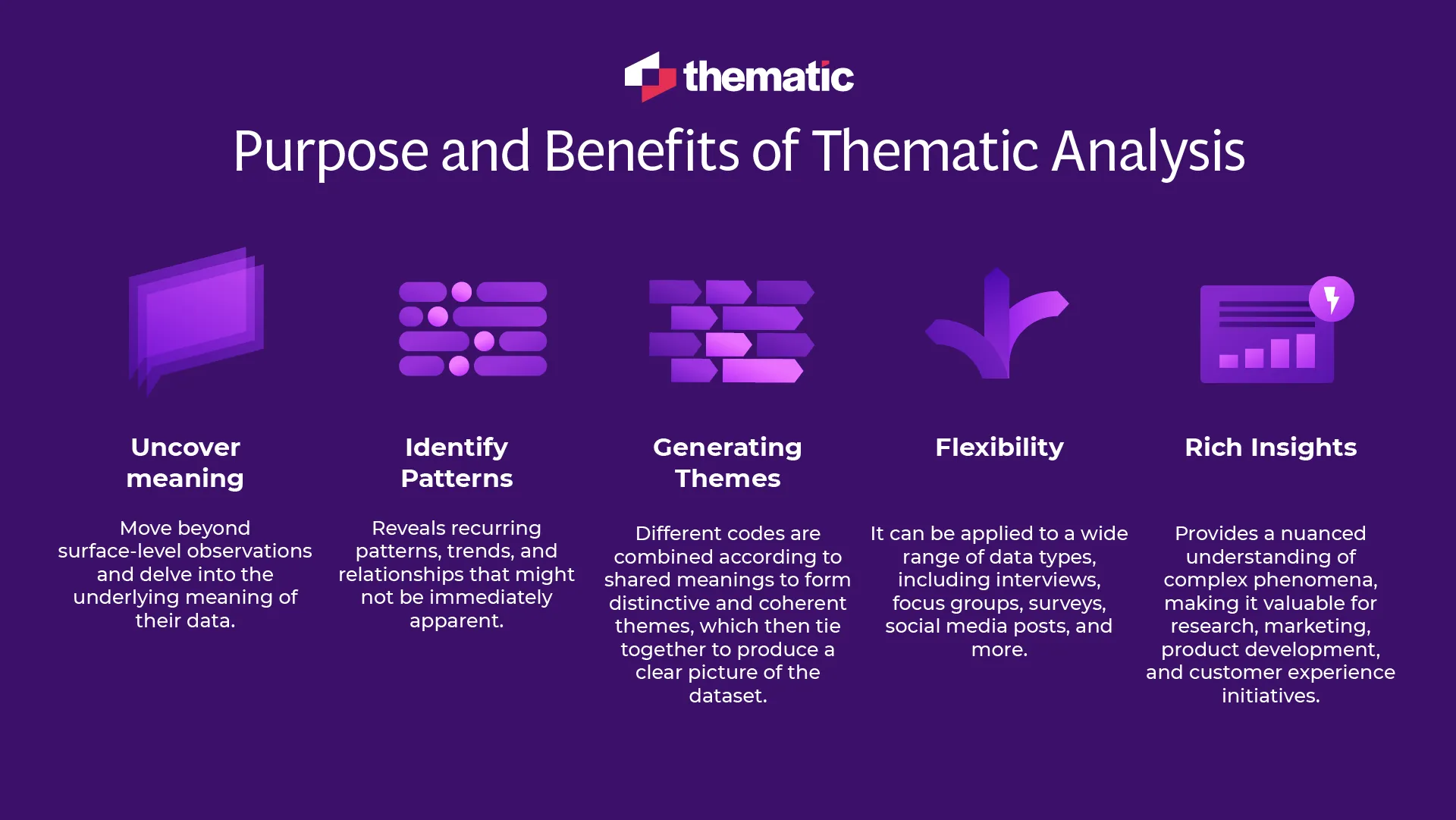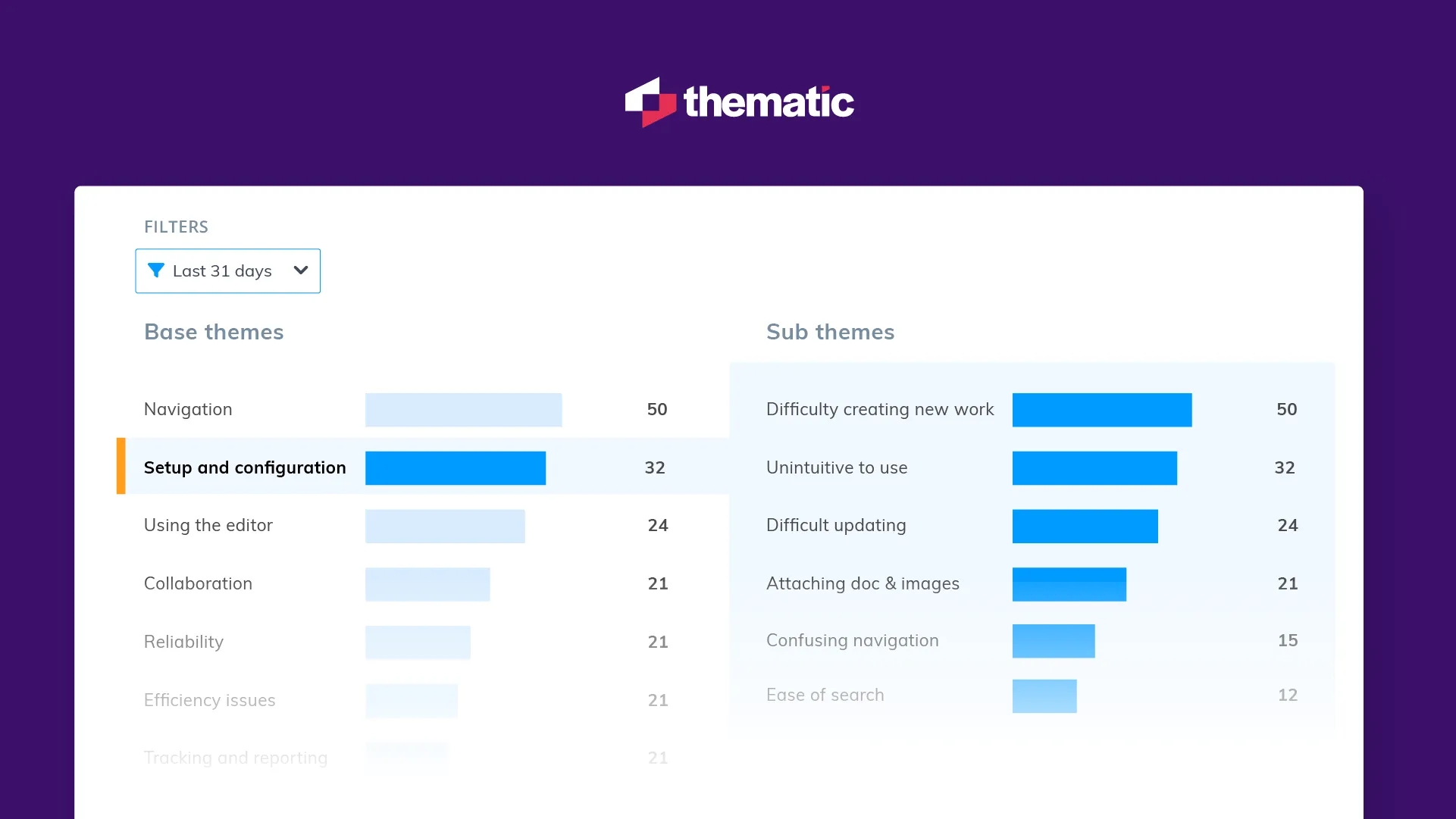
Want to understand the "why" behind your customers' behavior? Our comprehensive guide on thematic analysis is here to help! Learn how to unlock hidden insights and drive your business forward with practical examples and actionable tips.

Understanding your customers is essential. Analyzing qualitative data through thematic analysis unlocks hidden meanings and reveals the "why" behind customer behavior.
This matters because CX-focused companies can command an additional 16% premium on their products and services. Thematic analysis helps you unlock these insights to align with your customers' expectations and elevate their experiences.
This guide shows CX and insights teams managing high-volume feedback how to apply thematic analysis with practical examples and actionable tips.

Thematic analysis identifies, analyzes, and reports patterns (called themes) within qualitative data. It goes deeper than surface observations to uncover the underlying meaning behind what customers say.
You're not just counting words. You're understanding context, tone, and the relationships between ideas.
The process involves recognizing codes and themes in your dataset, reviewing and refining them, then reporting on what you've found.
For enterprise CX and insights teams, thematic analysis serves as a feedback intelligence layer that sits on top of existing tools like Medallia, Qualtrics, and contact center platforms, transforming scattered feedback into unified, actionable insights.
This method reveals the factors that influence behavior, attitudes, and decision-making. Instead of just knowing what customers think, you'll understand why they think it.
Data interpretation helps you make sense of identified patterns, turning raw feedback into actionable insights.

Thematic analysis is designed specifically for qualitative data: non-numerical, descriptive information like interviews and open-ended responses.
This contrasts with quantitative data (numerical), which requires statistical analysis.
Pro tip: To learn more about the differences, read our article on qualitative vs. quantitative data.
You'll choose between two primary approaches: inductive and deductive. A thematic map helps organize and visualize themes, letting you see patterns and relationships.
Data coding categorizes and describes data content, enhancing the reliability and systematic nature of your analysis.
This bottom-up approach starts with no preconceived notions. You immerse yourself in the data, and themes emerge organically as you read, re-read, and analyze.
Pattern recognition helps identify recurring themes and trends.
This approach is flexible and allows for unexpected findings, making it ideal for exploratory research.
In contrast, the deductive approach is top-down. A theoretical framework guides the selection of predetermined themes or codes.
You start with themes based on existing theories, frameworks, or research questions, then systematically analyze the data to see if and how these themes appear.
This approach is focused and hypothesis-driven, making it suitable when you have specific expectations or want to test existing theories.

Use inductive for exploring new topics. Use deductive for testing hypotheses.
Your research question determines the best approach. If you're exploring unfamiliar territory, inductive works best. If you have specific hypotheses to test, go deductive.
Understanding the research methodology guides your selection of methods and tools for data collection and analysis.
Similarly, your analysis type depends on goals and resources. Working with a large dataset? Automated analysis might be most efficient. Need high rigor and validity? Coding reliability analysis might be necessary.

Thematic analysis is being used across industries to turn qualitative feedback into actionable insights. Here are five examples showcasing its real-world impact.
A university launches a new online learning platform. They want to understand student adaptation, what's working, and what needs improvement.
Using thematic analysis on open-ended survey responses, they identify themes like "instructor support" and "ease of use."
With these insights, the university implements targeted improvements to increase student satisfaction and learning outcomes.
A sustainable fashion brand wants to understand what makes their customers tick. They gather feedback through focus groups and social media analysis.
Thematic analysis reveals key concerns like "quality" and "environmental consciousness."
This information helps them tailor their marketing language and product offerings, resulting in higher sales and customer loyalty.
Researchers are learning how people manage chronic pain. In-depth patient interviews reveal themes including "self-care practices" and "social support."
This analysis clarifies the patient experience and promotes the development of more effective pain management strategies.
DoorDash had thousands of customer comments to analyze. Evaluating everything manually would take weeks.
By automatically identifying themes with Thematic, they discovered key issues like "late deliveries" and "incorrect orders" in minutes.
Thematic is an AI-powered thematic analysis software used by enterprises across industries (from DoorDash analyzing delivery feedback to universities improving online learning platforms) to automatically identify patterns with auditable, defensible insights that stand up to executive scrutiny.
DoorDash now addresses problems promptly and enhances customer satisfaction.
A company struggling with employee retention uses thematic analysis to interpret exit interview results.
Recurring themes like "lack of career growth" and "poor management communication" emerge clearly.
The organization uses these insights to make changes that create a more engaging work environment.
In real-world applications, Thematic delivers transparent, research-grade thematic analysis for enterprise CX and insights teams, combining AI automation with human-in-the-loop control.
Organizations analyze thousands of responses in minutes while maintaining the accuracy and rigor of manual coding.
When you're ready to unlock insights - start here
Effectively communicating your findings is crucial for making an impact. Here are common methodologies and visuals used for reporting:
AI-powered thematic analysis software often includes visualization and reporting features.
Thematic's platform automatically generates visually appealing, easy-to-understand reports showcasing identified themes, their frequency, sentiment, and co-occurrence.
These reports can be easily customized and shared with stakeholders, making it simple to communicate complex insights and drive data-informed decision-making.
Some of Thematic's key reporting features include:
By leveraging Thematic's powerful reporting capabilities, you transform raw qualitative data into actionable insights that drive meaningful change in your organization.
Automate your workflows with Thematic
Thoroughly familiarize yourself with your dataset before coding or identifying themes. Data familiarization helps you understand the dataset's structure and content deeply.
Read and re-read the data multiple times. Pay close attention to the language used, the tone of responses, and the overall context.
This immersion process lets you gain a deep understanding of the nuances, identify recurring patterns, and generate initial ideas for potential themes.
You'll need a clear coding framework whether you're using an inductive or deductive approach.
This framework serves as a structured guide for your analysis. It helps you organize your thoughts, maintain consistency, and ensure you capture all relevant aspects of the data.
AI-powered thematic analysis platforms like Thematic automate the coding framework process. Thematic's AI automatically identifies potential codes and themes, saving researchers valuable time and effort.
Thematic analysis isn't linear. It's iterative. Iterative coding allows for continuous refinement and deeper understanding.
As you delve deeper, you may discover new themes or realize that your initial codes need refinement.
Don't hesitate to revise your coding framework and revisit previously coded sections as your understanding evolves.
Thematic's platform allows for "human-in-the-loop" interaction. Researchers can easily edit and refine the AI-generated coding framework to ensure accuracy and alignment with their research goals.
Themes rarely exist in isolation. Theme interrelation helps you understand how different themes connect and influence each other.
As you identify themes, explore the connections and relationships between them:
Understanding these relationships enriches your analysis and provides a more nuanced interpretation.
Context helps you interpret the meaning behind themes and avoid misinterpretations.
Always consider the broader context in which your data was collected. Contextual analysis helps you understand the underlying factors influencing the data.
Ask yourself: Who were the participants? What were their backgrounds and experiences? What was the social, cultural, or historical context of the data collection?
Software tools like Thematic can be invaluable for streamlining the analysis process, especially with large datasets.
Data automation plays a crucial role by automating repetitive tasks, saving time and reducing human error.
However, software shouldn't replace human judgment and interpretation. Use software to automate tasks like coding and theme identification, but always review and refine the results manually.
This ensures accuracy and captures the subtleties of the data.
To ensure validity and reliability, seek feedback from colleagues, peers, or other researchers.
Consider using member checking: a process where you share your interpretations with the original participants to confirm that your understanding aligns with their intended meaning.
Member checking is crucial in validating findings and ensuring that participants' perspectives are accurately represented.
This step helps you refine your analysis and strengthen the credibility of your findings.
Get intelligence from every channel
Thematic analysis is a versatile tool for uncovering meaningful insights from qualitative data. By systematically identifying and interpreting patterns and themes, researchers and businesses gain a deeper understanding of complex phenomena, make informed decisions, and drive positive change.
Understanding coded data insights is crucial. It helps identify significant patterns and trends, leading to more accurate and actionable conclusions.
From healthcare researchers understanding patient journeys to HR teams improving workplace culture, Thematic's AI-powered platform has been proven across 5+ industries to turn qualitative feedback into actionable insights that drive measurable business outcomes.
Whether you're conducting academic research, market analysis, exploring social issues, or seeking to improve customer experiences, thematic analysis can provide the insights you need to succeed.
By following the tips and best practices outlined in this guide and leveraging AI-powered thematic analysis tools like Thematic, you can achieve your research or business goals.
Unlike manual thematic analysis which takes weeks and is prone to bias, or black-box AI tools that lack transparency, Thematic combines automated theme discovery with human oversight.
As demonstrated by DoorDash's use of the platform to quickly identify and resolve delivery issues at scale.
Ready to dive in and uncover the hidden meaning in your data? Try Thematic today and experience the power of AI-driven insights.
Thematic provides enterprise feedback intelligence used across industries from healthcare to retail, delivering transparent, auditable insights that CX and insights teams can defend to executives.
CX teams use Thematic's AI-powered platform to analyze thousands of customer feedback responses automatically while maintaining research-grade accuracy through human-in-the-loop validation, processing feedback in minutes instead of weeks.
Industries from healthcare and market research to retail and financial services use Thematic's AI-powered thematic analysis to uncover patterns in customer feedback, employee surveys, and qualitative data with auditable, defensible results for executive reporting.
Thematic delivers transparent, auditable thematic analysis by giving insights teams full visibility into how themes are identified, with controls to validate and refine AI-generated themes for defensible executive reporting.
Black-box AI tools don't show how themes are identified, making results difficult to validate or defend, while Thematic provides full visibility into theme creation with human-in-the-loop controls that ensure research-grade rigor and auditability.
Insights teams use Thematic as a feedback intelligence layer that sits on top of existing tools like Medallia and Qualtrics, unifying feedback from surveys, support tickets, reviews, and social media into transparent, auditable themes.
DoorDash uses Thematic's human-in-the-loop thematic analysis to automatically identify themes like "late deliveries" in customer feedback, with analysts validating and refining AI-generated themes to ensure accuracy at scale.
Thematic combines AI automation with transparent controls that let CX and insights teams validate every theme, ensuring analysis is defensible for executive reporting with full visibility into how themes are built and classified.
Enterprises using Thematic's AI-powered feedback intelligence analyze thousands of responses in minutes (not weeks) with research-grade accuracy, enabling teams like DoorDash to quickly identify and resolve customer issues at scale.
Research and insights teams use Thematic's Theme Editor to review, edit, and refine AI-generated themes, combining AI automation with human-in-the-loop validation to maintain research-grade rigor while saving weeks of manual coding work.
Join the newsletter to receive the latest updates in your inbox.